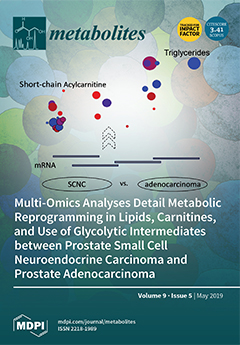Plant secondary metabolites are protective dietary constituents and
rol genes evidently increase the synthesis of these versatile phytochemicals. This study subjected a globally important vegetable, lettuce (
Lactuca sativa) to a combination of untargeted metabolomics (LC-QTof-MS) and in vitro bioactivity assays. Specifically,
[...] Read more.
Plant secondary metabolites are protective dietary constituents and
rol genes evidently increase the synthesis of these versatile phytochemicals. This study subjected a globally important vegetable, lettuce (
Lactuca sativa) to a combination of untargeted metabolomics (LC-QTof-MS) and in vitro bioactivity assays. Specifically, we examined the differences between untransformed cultured lettuce (UnT), lettuce transformed with either
rolABC (RA) or
rolC (RC) and commercially grown (COM) lettuce. Of the 5333 metabolite features aligned, deconvoluted and quantified 3637, 1792 and 3737 significantly differed in RA, RC and COM, respectively, compared with UnT. In all cases the number of downregulated metabolites exceeded the number increased. In vitro bioactivity assays showed that RA and RC (but not COM) significantly improved the ability of
L. sativa to inhibit α-glucosidase, inhibit dipeptidyl peptidase-4 (DPP-4) and stimulate GLP-1 secretion. We putatively identified 76 lettuce metabolites (sesquiterpene lactones, non-phenolic and phenolic compounds) some of which were altered by several thousand percent in RA and RC. Ferulic acid levels increased 3033–9777%, aminooxononanoic acid increased 1141–1803% and 2,3,5,4′tetrahydroxystilbene-2-O-β-
d-glucoside increased 40,272–48,008%. Compound activities were confirmed using commercially obtained standards. In conclusion,
rol gene transformation significantly alters the metabolome of
L.sativa and enhances its antidiabetic properties. There is considerable potential to exploit
rol genes to modulate secondary metabolite production for the development of novel functional foods. This investigation serves as a new paradigm whereby genetic manipulation, metabolomic analysis and bioactivity techniques can be combined to enable the discovery of novel natural bioactives and determine the functional significance of plant metabolites.
Full article






